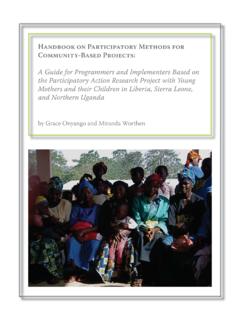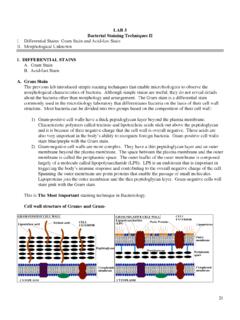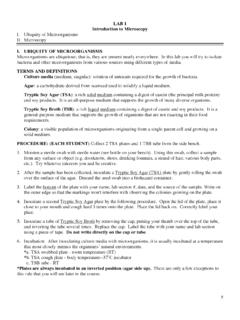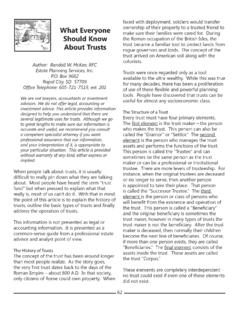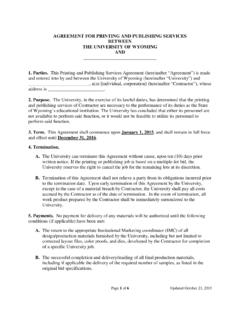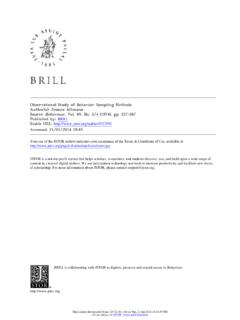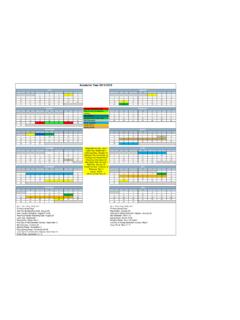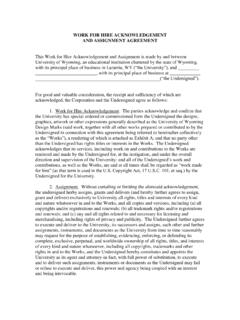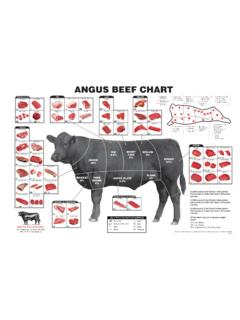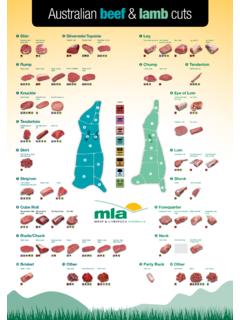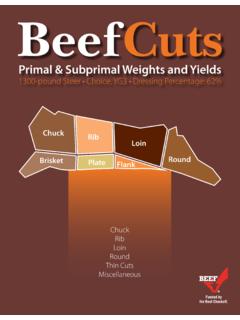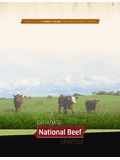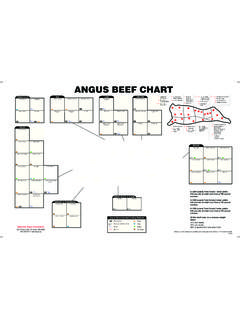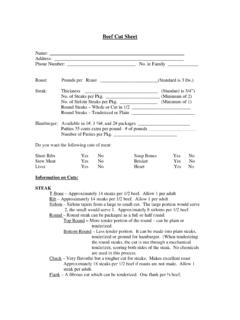Transcription of raising Freezer beeF: What does - Laramie, Wyoming
1 6 B A R N Y A R D S & B A C K Y A R D SLindsay Taylor is a UW CES educator serving Campbell, Crook, and Weston counties. She can be reached at (307) 682-7281 or buying a steer, lamb, or hog to raise for your Freezer next fall, first look into all of the associated costs to decide whether it is financially worthwhile. Most people pay attention to the main costs such as buying an animal and processing, and most people have a rough estimate of feed costs. This article provides some s go through a season in the life of a steer being raised for beef to calculate a steer calf is bought November 15. As of November 006, the market price for a 650-800 pound feeder steer is about $113/cwt (hundred weight or 100 pounds). A 700-pound steer calf would cost about $ is possible to raise beef at any point in the year; however, because of the calving season in the spring, calf prices are likely to be lower in the fall when most calves are sold.
2 Also, processors are busy with game animals in the fall and are more available in late spring and early summer to process the steer is brought home, facilities are needed. A water source, a feeder for hay, and some type of enclosure with a shelter are needed. Since providing these can be something fun for the family to do together, costs won t be assigned for the time taken to create the upon are a stock tank fed by a hose with a simple float valve, a used round bale feeder, a barbed wire fence, and a shelter made from six 4-foot by 8-foot sheets of plywood and four 4-inch by 8-foot posts. The most costly of these improvements will last through several steers. Those costs will be spread over seven start, the steer eats free choice grass hay purchased from a neighbor for $90/ton. The steer will consume roughly 15- 0 pounds of hay per day or percent of his body months before taking the steer to the processor, grain is added to his diet.
3 The amount of time on feed can vary from 60-150 days. For a backyard steer, 90 days on grain should be sufficient. The grain component will help him gain faster and change the flavor of the beef to more closely match what is purchased in the grocery store. This starts out as a 5-pound mixture of corn, oats, and barley per day. This ration will give the steer s digestive system a chance to get used to a higher concentrate diet. The grain is purchased from a local feed store for $9 per 50-pound bag. The grain component of the diet is slowly increased about a pound a day until he is eating 18- 0 pounds of the grain per day and 5 pounds of hay. On average, 15 pounds of grain a day is fed for 60 days. For more information about the health, nutrition, and production of beef cattle or other livestock animals, contact a local University of Wyoming Cooperative Extension Service (UW CES) office. A local office can be found online at unexpected expenses occur.
4 Sometime in January, the steer jumps out of his pen and gets into what s left of the barbed wire from the fencing project, and a veterinarian has to stitch his leg. The veterinarian vaccinates the steer for respiratory and clostridial diseases such as pneumonia and tetanus. The bill comes to $ early June, the steer weighs about 1,100 pounds and has a very fleshy appearance. He is carrying a noticeable fat cover over his ribs and hips. There is also some fat at the top of the tail. It is now time to take him Freezer beef : what doesraising W I N T E R 0 0 7 7 to the processor to get the end product. The processor charges $400 and returns 450 pounds of cut and wrapped beef . Taking into account the majority of cost related to raising this animal (not including time, labor, and hauling costs) the meat costs $ (lb).The price of beef in the grocery store ranges from $ to $ for hamburger, roasts, and other lower-end cuts. The loin cuts, like New York steaks and T-bones, range from $ to $ As this article is written, these are the average prices of retail beef cuts from two supermarkets in Gillette.
5 Of the 450 pounds of cut product received, approximately 30 percent (135 pounds) will be the higher-end middle cuts, and 70 percent (315 pounds) will be lower end cuts like chuck roasts and hamburger. The total spent on raising the beef is $1, The same amount of beef purchased in the store is estimated to cost $ ,081. 5. If this mixture of cuts matches the meal preferences of your family and no additional beef is purchased, you will be saving $ costs specific to your area into the charts for a more precise, localized estimate of expenses and are the economic costs of this endeavor. There are many intrinsic benefits and drawbacks to raising your own beef . raising a steer can be a good way to teach children responsibility for an animal dependent upon them for food and water. what has gone into the end product is known, so food safety may be less of a concern. Pride may also be taken in knowing your family took part in producing the food consumed.
6 On the other hand, there is a large time and space commitment. Feeding a steer twice a day, checking water, and monitoring health is more time intensive than the maintenance of a small pet such as a dog or cat. A steer and his facilities also take up a lot more your own Freezer s your choice!Feed90 days grain 00 days haydaily(lbs)fed(lbs)total tons/bagsprice ton/bagtotalHay153, tons$90$135 Grain (50 lb bags)151,350 7 bags$9$ 43 Total$378 Start Up CostsnumberpricetotalWater tank1$1 0$1 0 Hay feeder1$80$80 Wood posts4$10$40 Plywood6$10$60 Paint1$30$30T-posts 0$5$100 Barbwire1$45$45 Grand total$475 Total for one year (depreciation over seven years)$ of Production450 lbs beefCost of steer$800 Start-up$68 Feed$378 Vet$ 00 Processing$400 Total$1,846 Per lb beef $ Cost for BeefProductaverage costamount (lbs)price paidLower end cuts$ $1, end cuts$ $ $1,845 Retail Cost for BeefProductaverage costamount (lbs)price paidLower end cuts$ .99315$ end cuts$ $1, $ ,081.
7 5it really co$t?
